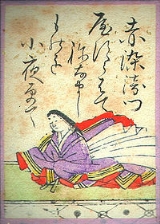
Akazome Emon
Encyclopedia
was a Japanese
waka
poet who lived in the mid-Heian period
. She is a member both of the and the .
Akazome Emon served Genrinshi and Fujiwara no Shōshi, respectively the wife and daughter of Fujiwara no Michinaga
, and she was present at the Imperial court at the same time as Izumi Shikibu
. She was a contemporary of Murasaki Shikibu
, who praised her writing, and Sei Shōnagon
. She took part in two poetry competitions in 1035 and 1041.
A collection of her poetry is published as the . She is believed to be the chief author or compiler of the Eiga Monogatari
.
Japanese people
The are an ethnic group originating in the Japanese archipelago and are the predominant ethnic group of Japan. Worldwide, approximately 130 million people are of Japanese descent; of these, approximately 127 million are residents of Japan. People of Japanese ancestry who live in other countries...
waka
Waka (poetry)
Waka or Yamato uta is a genre of classical Japanese verse and one of the major genres of Japanese literature...
poet who lived in the mid-Heian period
Heian period
The is the last division of classical Japanese history, running from 794 to 1185. The period is named after the capital city of Heian-kyō, or modern Kyōto. It is the period in Japanese history when Buddhism, Taoism and other Chinese influences were at their height...
. She is a member both of the and the .
Biography
Emon is though to be the daughter of Akazome Tokimochi, but her biological father was likely her mother's first husband, Taira Kanemori. Emon was born before her mother's marriage to Tokimochi in the Akazome family. Her husband Ōe no Masahira was a famous literary scholar, and the couple were considered to be . She had two children, Ōe no Takachika and Gōjijū, and at least one grandchild, Ōe no Masafusa. In 1012, after her husband drowned, she lost her interest in religion and in raising her children.Akazome Emon served Genrinshi and Fujiwara no Shōshi, respectively the wife and daughter of Fujiwara no Michinaga
Fujiwara no Michinaga
represents the highpoint of the Fujiwara regents' control over the government of Japan.-Early life:He was the fourth or fifth son of Fujiwara no Kaneie by his wife Tokihime, daughter of Fujiwara no Nakamasa...
, and she was present at the Imperial court at the same time as Izumi Shikibu
Izumi Shikibu
was a mid Heian period Japanese poet. She is a member of the . She was the contemporary of Murasaki Shikibu, and Akazome Emon at the court of Joto Mon'in.-Early life:...
. She was a contemporary of Murasaki Shikibu
Murasaki Shikibu
Murasaki Shikibu was a Japanese novelist, poet and lady-in-waiting at the Imperial court during the Heian period. She is best known as the author of The Tale of Genji, written in Japanese between about 1000 and 1012...
, who praised her writing, and Sei Shōnagon
Sei Shonagon
Sei Shōnagon , was a Japanese author and a court lady who served the Empress Teishi around the year 1000 during the middle Heian period. She is best known as the author of The Pillow Book .-Name:...
. She took part in two poetry competitions in 1035 and 1041.
A collection of her poetry is published as the . She is believed to be the chief author or compiler of the Eiga Monogatari
Eiga monogatari
is a Japanese monogatari, or epic, which relates events in the life of courtier Fujiwara no Michinaga. It is believed to have been written by a number of authors, over the course of roughly a century, from 1028 to 1107....
.
Poetry examples
- Akazome Emon composed this poem upon learning that Ōe no Tamemoto was headed to the . This is a ; several official poetry anthologies followed the lead of Kokin Wakashū in having entire chapters devoted to such poems of parting. While the poem appears on the surface to be a trivial remark, she had no hope of Ōe no Tamemoto ever returning; thus this poem is an unsaid goodbye.
- 惜ともなき物ゆへにしかすがの 渡と聞けばたゞならぬ哉
- woshimu tomo nakimono yuhe ni shikasuga no watari to kikeba tada naranu kana (classical kanaKanaKana are the syllabic Japanese scripts, as opposed to the logographic Chinese characters known in Japan as kanji and the Roman alphabet known as rōmaji...
orthography) - loosely: Though I have no reason for regret, upon hearing that you are headed to Shikasuga I am not completely indifferent.
- (Shūi Wakashū 6:316, written c. 985)
- This poem was composed on the anniversary of Ōe no Mashashira's death. This is a classic example of explicit seasonal reference, pioneered in the poems on seasons in the Kokin Wakashū, that is typical of HeianHeian periodThe is the last division of classical Japanese history, running from 794 to 1185. The period is named after the capital city of Heian-kyō, or modern Kyōto. It is the period in Japanese history when Buddhism, Taoism and other Chinese influences were at their height...
poetry.- こぞの春ちりにし花も咲きにけり 哀れ別のかゝらましかば
- kozo no haru chirinishi hana mo sakinikeri ahare wakare no kakaramashikaba (classical kana orthography)
- loosely: The fallen blossoms of last spring are in bloom again. Oh if it were so with our painful parting!
- (Shika Wakashū 10:402)

